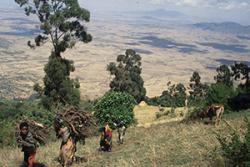Ethiopian ‘Church Forests’ are a crucial resource deserving of world heritage status
 Debre Libanos monastery with its waterfall and sacred forest.Nearly all of the natural forest cover has been lost in the highlands of Ethiopia, except for small areas of sacred forest surrounding the many individual churches of the Ethiopian Tewahedo Orthodox Church.
Debre Libanos monastery with its waterfall and sacred forest.Nearly all of the natural forest cover has been lost in the highlands of Ethiopia, except for small areas of sacred forest surrounding the many individual churches of the Ethiopian Tewahedo Orthodox Church.
The first study to assess the conservation value of these forests has shown that the Ethiopian ‘church forests’, as they are known, play a crucial role in the protection of many species in this global biodiversity hotspot. Although these forests are managed individually, together they form an important network of habitats spread right over the vast area of the central and northern highlands of Ethiopia.
The paper, published in the journal Science of the Total Environment, also identifies the main challenges to the survival of the biodiversity of these forests, such as disturbance and climate change. It makes key recommendations for their protection and improvement. They owe their survival to the high cultural, spiritual and religious values with which they are associated. However, sustaining them in the future will require improved national policies to strengthen the conservation and management of the forests by the Church and local communities.
John Healey, Professor of Forest Sciences at Bangor University’s School of Environment, Natural Resources & Geography and an author of the paper, said:
 Fuelwood gathering from a church forest, which risks causing forest degradation but could be managed sustainably. “The Ethiopian Church Forests are a globally and locally important natural resource that can continue to provide important benefits for both conservation of the world’s biodiversity and the local communities who use them. Because of their outstanding universal value there is a very good case for adding these forests to the UNESCO World Heritage List. They already meet an impressive six of the ten criteria, whereas one is the minimum requirement.”
Fuelwood gathering from a church forest, which risks causing forest degradation but could be managed sustainably. “The Ethiopian Church Forests are a globally and locally important natural resource that can continue to provide important benefits for both conservation of the world’s biodiversity and the local communities who use them. Because of their outstanding universal value there is a very good case for adding these forests to the UNESCO World Heritage List. They already meet an impressive six of the ten criteria, whereas one is the minimum requirement.”
“Sacred forests, such as the Ethiopian church forests, are found in many cultures around the world. They play an important role in sustaining the cultures as well as conserving the biodiversity that depends on these habitats,” he added.
The paper concludes: “The inclusion of the church forests in the Tentative List of Ethiopian natural and cultural heritage sites and, ultimately, its inscription on UNESCO's World Heritage List would provide timely and well-deserved recognition of the exceptional religious, natural and cultural value of Ethiopia's church forests. The management and policy issues of Ethiopian church forests have global relevance, because small and isolated forest patches and woodlots are becoming increasingly important as global deforestation and forest fragmentation continue.”
Publication date: 7 March 2016
